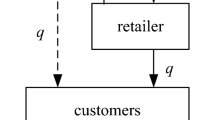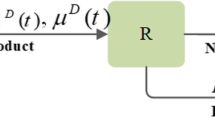Abstract
Facing the threat of market follower encroachment, this paper constructs game theoretical models based on different channel structures and market structures, investigates following manufacturer’s encroachment strategy and technology strategies, and discusses the impact of following manufacturer’s strategy on quality decisions. The results show that encroachment always improves consumer surplus by slashing prices when leading manufacturer adopts in-house R&D (IRD); otherwise, it results in lower consumer surplus with mild competition if leading manufacturer is at a technological disadvantage. Furthermore, the technology strategies of following manufacturer are related to their R&D capabilities. The superior one is outsourcing R&D (ORD) for the manufacturers when their R&D capability is weak, otherwise, IRD is optimal. In a word, the leading manufacturer always prefers IRD under certain conditions, while the following manufacturer always prefers ORD. In addition, encroachment restrains quality innovative motivation under fixed or quality-sensitive R&D costs, but can improve quality level when consumers have a higher reference dependency for quality; meanwhile, the following manufacturer adopting ORD is always beneficial to quality improvement.
Similar content being viewed by others
References
Apesteguia J, Ballester M A (2009). A theory of reference-dependent behavior. Economic Theory 40(3): 427–455.
Arya A, Mittendorf B, Sappington D (2017). The bright side of supplier encroachment. Marketing Science 26(5): 651–659.
Avinadav T, Chernonog T, Fruchter GE, Prasad A (2020). Contract design when quality is co-created in a supply chain. European Journal of Operational Research 286(3):908–918.
Becker M C, Zirpoli F (2017). How to avoid innovation competence loss in R&D outsourcing. California Management Review 59(2): 24–44.
Beneito P (2006). The innovative performance of in-house and contracted R&D in terms of patents and utility models. Research Policy 35(4): 502–517.
Chen J, Liang L, Yao D (2019a). Factory encroachment and channel selection in an outsourced supply chain. International Journal of Production Economics 215: 73–83.
Chen J, Liang L, Yao D, Sun S (2017). Price and quality decisions in dual-channel supply chains. European Journal of Operational Research 259(3): 935–948.
Chen J, Wang X, Zhou M (2019b). Firms’ green R&D cooperation behaviour in a supply chain: Technological spillover, power and coordination. International Journal of Production Economics 218: 118–134.
Cui Q (2019). Quality investment, and the contract manufacturer’s encroachment. European Journal of Operational Research 279(2): 407–418.
Eggers J P, Park K F (2018). Incumbent adaptation to technological change: The past, present, and future of research on heterogeneous incumbent response. Academy of Management Annals 12(1): 357–389.
Fu Y, Lai K K, Liang L (2013). Bricks or clicks. Asia Pacific Journal of Marketing and Logistics 25(4): 695–714.
Gao S Y, Lim WS, Tang C (2017). The impact of the potential entry of copycats: Entry conditions, consumer welfare, and social welfare. Decision Sciences 48(4): 594–624.
Galera F, Garcia-del-Barrio P, Mendi P (2019). Consumer surplus bias and the welfare effects of price discrimination. Journal of Regulatory Economics 55(1): 33–45.
Gneezy A, Gneezy U, Lauga D O (2014). A reference-dependent model of the price-quality Heuristic. Journal of Marketing Research 51(2): 153–164.
Guan X, Wang Y, Yi Z (2020). Inducing consumer online reviews via disclosure. Journal of Marketing Research 51(2): 153–164.
Ha A, Long X, Nasiry J (2016). Quality in supply chain encroachment. Manufacturing & Service Operations Management 18(2): 280–298.
Hou J, Mohnen P (2013). Complementarity between in-house R&D and technology purchasing: Evidence from Chinese manufacturing firms. Oxford Development Studies 43(1): 343–371.
Hu F, Zhou Z (2020). Monopoly or competition strategic analysis of a retailing technology service provision. Electronic Commerce Research: 1–39. DOI: https://doi.org/10.1007/s10660-020-09426-z.
Hu Y, Qu S, Li G, Sethi S P (2021). Power structure and channel integration strategy for online retailers. European Journal of Operational Research 294(3):951–964.
Huang S, Guan X, Chen Y (2018). Retailer information sharing with supplier encroachment. Production and Operations Management 27(6):1133–1147.
Jenkins M (2014). Innovate or imitate? The role of collective beliefs in competences in competing firms. Long Range Planning 47(4):173–185.
Li H, Leng K, Qing Q, Zhu SX (2018a). Strategic interplay between store brand introduction and online direct channel introduction. Transportation Research Part E: Logistics and Transportation Review 118: 272–290.
Li M, Sethi S P, Zhang J (2016). Competing with bandit supply chains. Annals of Operations Research 240(2): 617–640.
Li S, Cheng H K, Jin Y (2018b). Optimal distribution strategy for enterprise software: Retail, SaaS, or dual channel? Production and Operations Management 27(11): 1928–1939.
Li T, Xie J, Zhao X (2015). Supplier encroachment in competitive supply chains. International Journal of Production Economics 165: 120–131.
Li W, Chen J, Chen B (2020). Sourcing strategy of original equipment manufacturer with quality competition. International Journal of Production Economics 51(5): 1110–1130.
Lin X, Zhou Y, Hou R (2021). Impact of a “Buy-online-and-pickup-in-store” channel on price and quality decisions in a supply chain. European Journal of Operational Research 294(3): 922–935.
Liu J, Sun R, Liu F (2020a). Outsourcing strategy with patent licensing in an electronic product supply chain. IEEE Access 8: 98359–98368.
Liu X, Kim B C (2020b). Keep it or kill it the optimal management of old technology based products in the prevalence of new technology based products. Journal of the Operational Research Society. DOI:https://doi.org/10.1080/01605682.2020.1806744.
Munro A, Sugden R (2003). On the theory of reference-dependent preferences. Journal of Economic Behavior & Organization 50(4): 407–428.
Nie J, Zhong L, Yan H, Yang W (2019). Retailers’ distribution channel strategies with cross-channel effect in a competitive market. International Journal of Production Economics 213: 32–45.
Radicic D, Balavac M (2018). In-house R&D, external R&D and cooperation breadth in Spanish manufacturing firms: Is there a synergistic effect on innovation outputs? Economics of Innovation and New Technology 28(6): 590–615.
Shi H, Liu Y, Petruzzi N C (2013). Consumer heterogeneity, product quality, and distribution channels. Management Science 59(5): 1162–1176.
Souto J E (2015). Business model innovation and business concept innovation as the context of incremental innovation and radical innovation. Tourism Management 51: 142–155.
Tojeiro-Rivero D, Moreno R (2019). Technological cooperation, R&D outsourcing, and innovation performance at the firm level: The role of the regional context. Research Policy 48(7): 1798–1808.
Ulhøi J P (2012). Modes and orders of market entry: Revisiting innovation and imitation strategies. Analysis & Strategic Management 24(1): 37–50.
Varian H R (1992). Microeconomic Analysis. W. W. Norton & Company, New York.
Wu J, Harrigan K R, Ang S H, Wu Z (2017). The impact of imitation strategy and R&D resources on incremental and radical innovation: Evidence from Chinese manufacturing firms. The Journal of Technology Transfer 44(1): 210–230.
Xue M, Zhang J, Tang W, Dai R (2017). Quality improvement and pricing with reference quality effect. Journal of Systems Science and Systems Engineering 26(5): 665–682.
Zeng H, Zhang Y (2019). Two retailers’ competitive pricing considering strategic consumer behavior and imitation products with quality uncertainty. Journal of Industrial Engineering and Engineering Management 33(1): 214–221.
Zhang J, Li S, Zhang S, Dai R (2019a). Manufacturer encroachment with quality decision under asymmetric demand information. European Journal of Operational Research 273(1): 217–236.
Zhang S, Zhang J, Zhu G (2019b). Retail service investing: An anti-encroachment strategy in a retailer-led supply chain. Omega 84(3): 212–231.
Zhou J, Huang H, Gao Z, Zhu G, Yan Z (2021). Bias and reference-dependence in quality perception of freshness: Analysis based on experimental auction and physical & chemical tests. Food Control 126: 108077.
Zhou J, Zhu J, Wang H (2019). Strategic cooperation with differential suppliers’ ability under downstream competition in complex products systems. Journal of Systems Science and Systems Engineering 28(4): 449–477.
Acknowledgments
The authors would like to express their gratitude to the editors and the anonymous reviewers for their encouraging comments and insightful suggestions, which substantially improved the quality of this paper. This work was supported by the National Natural Science Foundation of China under Grant No. 71771044.
Author information
Authors and Affiliations
Corresponding author
Additional information
Chunyu Li is a PhD student of School of Business Administration at Northeastern University, Shenyang, China. She received the B.S. and M.S. degrees from Northeastern University, Shenyang, China, in 2013 and 2015, respectively. Her research interests include supply chain optimization and quality improvement.
Cuihua Zhang is a professor at Northeastern University, Shenyang, China. Her current research interests include behavioral and service operations management, supply chain quality control. She has published academic papers in many journals, such as International Journal of Operational Research, Computers & Industrial Engineering, Journal of Cleaner Production, Journal of Systems Science and Information.
Yanting Li is currently working towards the Ph.D. degree in management science and engineering at Northeastern University, Shenyang, China. Her research results have been published in the Computers & Industrial Engineering. Her major research interests include logistics and supply chain management, and decision-making optimization.
Ruxia Lv is currently working towards the Ph.D. degree in management science and engineering at Northeastern University, Shenyang, China. Her research results have been published in the Journal of Cleaner Production. Her research interest is green supply chain management and government regulations.
Rights and permissions
About this article
Cite this article
Li, C., Zhang, C., Li, Y. et al. In-house or Outsourcing R&D? Manufacturer Technology Strategy in the Presence of Market Follower Encroachment. J. Syst. Sci. Syst. Eng. 31, 64–88 (2022). https://doi.org/10.1007/s11518-021-5513-5
Published:
Issue Date:
DOI: https://doi.org/10.1007/s11518-021-5513-5




